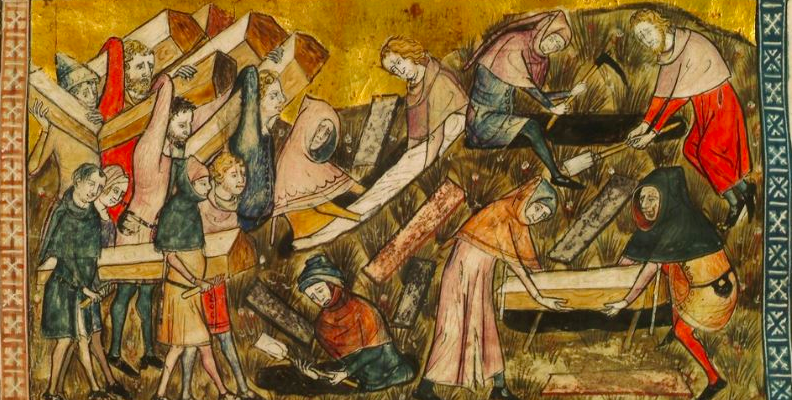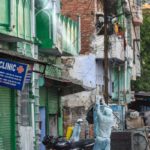Sharadindu Bandyopadhyay’s Bengali short story Shada prithibi (1946) or ‘The White World’ begins on an ominously theatrical note.
The scene is set in London, and the protagonist is Sir John White, the preeminent scientist and philosopher of the day.
On August 6, 1946, at around 3 in the morning, Sir John suddenly finds the solution to the puzzling riddle that has occupied the most of his eighty-year long life. “Like the unbearable brightness of a thousand atomic bombs,” a brilliant idea flashes in his head, and almost immediately he calls up a conservative British parliamentarian to tell him in a trembling voice that he has finally found the “salvation for the white races.”
On January 5, 1947, an op-ed article in a “middle-rung Tory newspaper” elaborates on this plan and proposes a rather diabolical project for the welfare of the white races.

Sharadindu Bandyopadhyay
Identifying the growing population of the world as the greatest threat to humankind, the author of the article uses Malthusianism and social eugenics to argue that for the continued wellbeing of the white races it has become necessary to eliminate all the other races—“black, yellow, brown, mixed”—and to ensure the “survival of the fittest.”
It turns out that this is no mere daydreaming, as most readers of the newspaper suspect initially, and in fact is a project already in operation. The first incident takes place in the USA on June 25, 1948. After a long battle, the black population of the US are able to establish a state of their own — located between Arizona and Mexico, it is called Mexariz.
On this fateful day an unmanned aeroplane carrying a new prototype of atomic bomb accidentally crashes in the capital of Mexariz and detonates the bomb. As a consequence, the Reuters’ reporter fears, all the inhabitants of the capital dies.
This pattern repeats itself next in South Africa. As a solution to the race question, and also as a political step to strengthen the British Commonwealth, the settler white population of the country are relocated to Australia.
However, after the whites leave South Africa, the native black population comes under the grip of an unidentified pandemic and dies. In South America, around the same time, news agencies begin to report the outbreak of an unknown virus that does not show any symptom in affected bodies but kills them almost instantly.
Gradually, and with sinister precision, the pandemic spreads across the non-white world, killing millions. China, Burma, the Philippine islands, and countless other countries try to contain the spread of the pandemic through strict quarantine and restricted mass mobility.
In India things are no different.
After the Independence, all the white men and women leave the subcontinent following the decrees of their respective governments. And the first death occurs almost immediately in Calcutta, on June 7, 1949. Within days, panic and the virus spread like wildfire, and the citizens of free (and in Bandyopadhyay’s imagination, undivided) India die like flies.
Also read: Nizamuddin, the Newest Chapter in the Assamese Distrust of the ‘Miya’
By August 6, 1950, exactly after four years of Sir John’s inspired conception of the “salvation,” all the non-white races of the world are wiped out from the face of the earth because of this unknown pandemic. In the meantime, however, Sir John is conferred with a Nobel prize in 1949, at the age of 83.
Bandyopadhyay’s story compels us to rethink the fraught relationship between pandemics and politics.
This is of course a long history as several studies have shown. In his lecture series Abnormal (1974-75), Michel Foucault shows how the management of plague pandemics in Europe between the Middle Ages and the nineteenth century produced some of the central templates of the modern state, especially the individualised subject and the elaborate mechanisms of surveillance.
Closer home, David Arnold’s Colonizing the Body (1993) argues that the finer nuances of the colonial state in India between 1800 and 1914 were shaped by the state’s response to large-scale epidemics like smallpox, cholera, and plague, as also by the deployment of the idea of public medicine, distinct from traditional medical practices.

A ward in Parel hospital showing a plague stricken child, 1896. Caption and photo: Wellcome Library
In the more recent experiences of pandemic, two political questions have haunted the international community. The first concerned securitisation and surveillance; while the second revolved around the market economy.
The threat of SARS in 2004 exposed not only the endemic racial bias in creating the diseased “other” but also brutal measures of non-pharmaceutical social exclusion taken by the states to curb the threat of microbial spread. In case of the US during the SARS threat the much older racial profiling of Chinese-Americans and the perceived spatial danger around Chinatowns within US cities resurfaced with a vengeance, imitating the plague pandemics of the nineteenth century.
The process of securitisation that runs on the principle of eliminating a possible threat through strong surveillance results in stricter border control (especially in case of population and goods moving in from susceptible nations, read third world countries, to the developed world, read the West wherever it resides geographically), forced quarantine and absolute isolation.
And yet, such measures may not be enough in controlling the pandemic due to the inherent stereotypes within the security systems.
Elimination of human rights for the economically vulnerable migrant population strengthens state power, but in absence of pharmaceutical measures and proper public health policies, such enhancement in state power leaves the national population, the “self” of West, open to any “accidental” spread of the disease.
And we know from our long experiences as civilians of an increasingly strong military-industrial system of governance that accidental slips in the security threats are not uncommon.
The second question of market economy is directly connected to the stricter control of labouring population.
Our contemporary world, what historian Tim Mitchell calls “carbon democracy,” is reliant on the international mobility of cheap labour. The violence around the scramble for oil, as oil is the primary fuel for carting the labour from one location to another, is exactly proportional to the coverage of finance capital. In the current pandemic language of “lockdown” precisely this mobility comes to an absolute halt.
Also read: COVID-19 Pandemic: Should You Believe What the Models Say About India?
As the juggernaut of market economy collides with the impenetrable fear-psychosis of pandemic, the world economy crumbles.
Decades of austerity measures in disinvesting the public health, scientific research, and state responsibilities of the populations’ standard of living come to a naught when the poor from foreign shores stops moving and selling its labour, and even worse dies out. The illusion of productivity during “lockdown” sustains the freedom of market economy for a while as the charitable offers from CEOs, who were bailed out in economic recession, are lauded as humanitarian measures.
The pandemic, however, has little sense of safeguarding the leaders who have come to power with the slogan of “make X country great again” and rams into the already nose-diving “free” market.
As the propagator of “herd immunity” is forced into quarantine, it is the much-maligned public health system with its creaking, under-nourished components that has to keep the ventilator running, in the hope of survival.

Medical staff with protective clothing inside a ward specialised in receiving any person who may have been infected with coronavirus, at the Rajiv Ghandhi Government General hospital in Chennai. Photo: Reuters/P. Ravikumar/File Photo
Bandyopadhyay’s story, however, points toward another possibility.
Instead of taking us through the emerging techniques of governance as we worry about the possible political life after COVID-19, it simply suggests pandemic as an end of politics.
In Sir John’s Manichean scheme of things, the world is simply divided between two groups — the whites and the nonwhites — and it is the annihilation of the latter that facilitates the survival of the former. After the apocalyptic end of all the nonwhite races from the pandemic there will be no conflict and hence no politics; as the author of an editorial piece in the story observes:
“There will be no need for men to fight over land. There will be no race question. The future of the humankind will be secured for at least two thousand years.”
This is a frightening future indeed. However, pandemics have their own ways of asserting lives and disturbing the neatness of a conservative fantasy.
In the final section of the story, Sir John attends a large gathering in London and defends his diabolical project by arguing that mother nature is beyond human emotions like sympathy and kindness as she only favours the fittest.
With great pleasure he informs the huge gathering that the plea for survival of the white races have been accepted at the court of mother nature. At this points Sir John suddenly stops and, like so many millions of non-white people before him, falls headlong on the dais and dies.
Mallarika Sinha Roy is assistant professor at the Centre for Women’s Studies, School of Social Sciences, Jawaharlal Nehru University. Baidik Bhattacharya is associate professor of the Centre for the Study of Developing Societies (CSDS).




